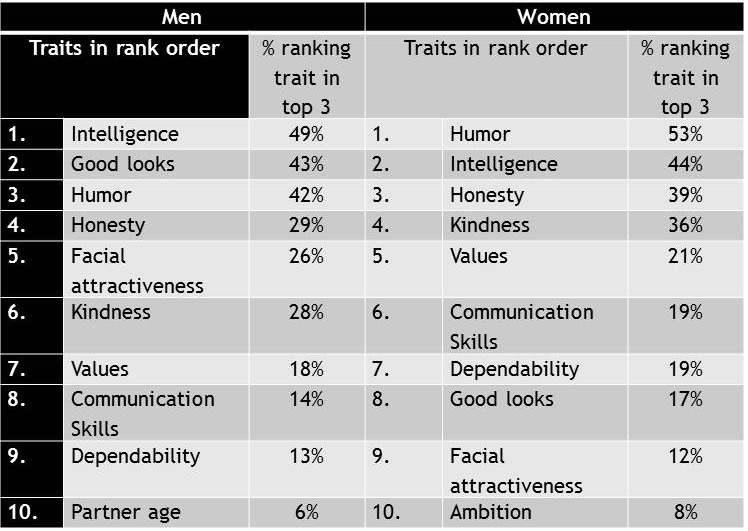9 Out of the Top 10 Traits Men and Women Want In a Romantic Partner are the Same
January 30, 2019 by Justin Lehmiller
When it comes to what men and women want in a romantic partner, they’re stereotyped as wanting drastically different things. However, research suggests that they actually have a lot in common.
Consider this online survey that included a sample of 102,961 heterosexual men, 5,938 gay men, 82,819 heterosexual women, and 2,548 lesbian women [1]. Participants came from 53 different countries, but most were from the United Kingdom or the United States.
As part of this survey, participants were given a list of 23 different traits and they were asked to select the top three traits that were most important in a potential romantic partner. Researchers then rank ordered the traits based upon how many participants put each trait in their top three. The top 10 traits for men and women are listed in the table below, collapsing across sexual orientation.

As you can see, 9 out of the top 10 traits were the same for men and women. The only exception was that partner age made it onto the men’s list, whereas ambition made it onto the women’s list. Furthermore, 3 out of the top 4 traits were the same across the sexes: both men and women said they want a partner who is intelligent, funny, and honest.
This list suggests that men value physical attractiveness (including overall good looks and facial attractiveness) somewhat more than women, however, and this was by far the biggest sex difference to emerge in the study. To be clear, this is not to say that looks were unimportant to women—attractiveness still placed quite high on the women’s list; it’s just that a few psychological traits appeared to be more important to women than looks.
Also noteworthy is the fact that neither money nor social status appeared among the top 10 traits for women, despite everything we’ve heard about women being drawn to partners with these characteristics. In fact, these traits were all the way down at numbers 20 and 21, respectively. Money and social status were almost equally low on the men’s list (numbers 21 and 22, respectively).
Overall, sexual orientation did not appear to make a huge difference in what people valued in a partner; however, there were a few exceptions. For example, heterosexual men and women reported valuing their partners’ religion and parenting abilities more than gay men and lesbians. In addition, gay men reported valuing partner age more than heterosexual men, and lesbians reported valuing intelligence more than heterosexual women.
One caveat to all of this is that what we say we want in a partner on surveys doesn’t necessarily reflect the partners we actually choose in real life. Sometimes we go for people who don’t match our stated preferences at all, and that’s because attraction is a very dynamic thing. Our emotional state and arousal level during an in-person interaction has the potential to change who we’re attracted to. In other words, what we say we want and what we actually do can be two quite different things.
That said, regardless of sex and sexual orientation, this research tells us that we seem to have a lot more in common when it comes to romantic attraction than you might think. There are undeniably some differences in the relative value that different groups place upon a given trait (like physical appearance) and we would do well to acknowledge those differences—but we appear to be more similar than different overall in terms of what attracts us to a partner.
Want to learn more about Sex and Psychology ? Click here for previous articles or follow the blog on Facebook (facebook.com/psychologyofsex), Twitter (@JustinLehmiller), or Reddit (reddit.com/r/psychologyofsex) to receive updates. You can also follow Dr. Lehmiller on YouTube and Instagram.
[1] Lippa, R.A. (2007). The preferred traits of mates in a cross-national study of heterosexual and homosexual men and women: An examination of biological and cultural influences. Archives of Sexual Behavior, 36, 193-208. doi:10.1007/s10508-006-9151-2
Image Source: 123RF
You Might Also Like:

Dr. Justin Lehmiller
Founder & Owner of Sex and PsychologyDr. Justin Lehmiller is a social psychologist and Research Fellow at The Kinsey Institute. He runs the Sex and Psychology blog and podcast and is author of the popular book Tell Me What You Want. Dr. Lehmiller is an award-winning educator, and a prolific researcher who has published more than 50 academic works.
Read full bio >


